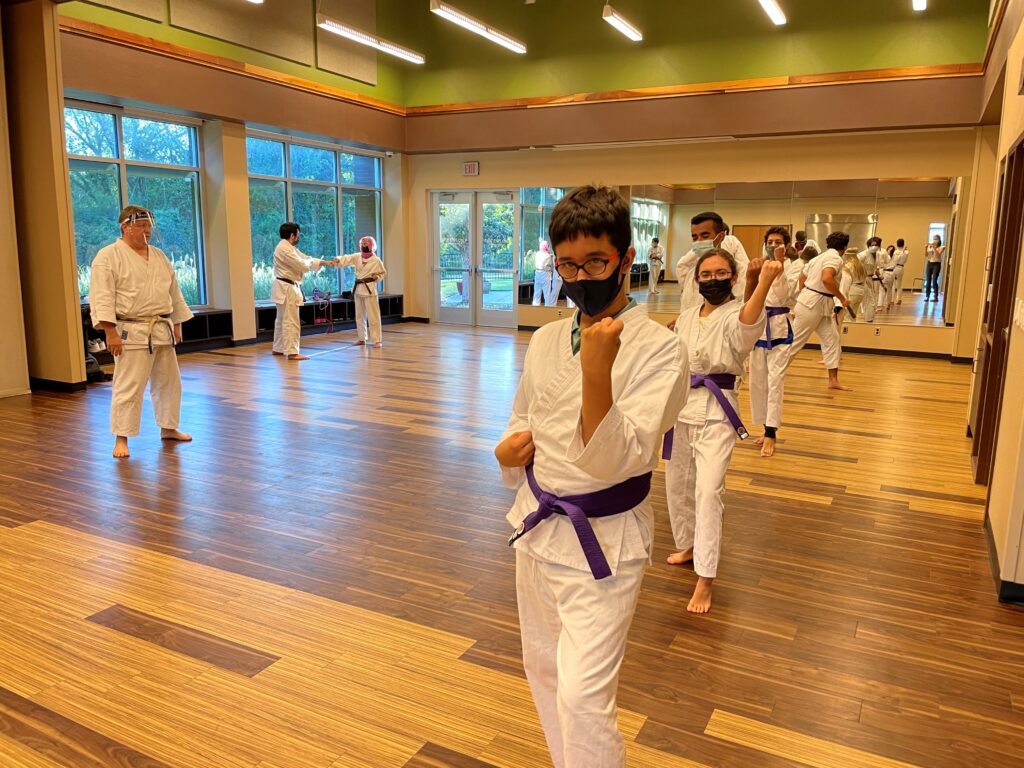Each Tuesday and Friday evening at Heights Recreation Center, students clad in traditional white uniforms and colorful belts learn and apply karate concepts under the instruction of their senseis (teachers).
This fall, four Beyond Karate teen and young adult participants are testing to earn their black belts. These students have achieved beyond any limitations of disability. Instructor Witek Nowosiad began the program in 2014 with the support of master karate instructor Takao Nakaya. Beyond Karate is part of the larger organization, Ryubukai Karatedo, led by Nakaya.
Nowosiad’s passion for karate began as a young man growing up in Poland. Watching Bruce Lee on the big screen, Nowosiad admired martial arts. In 2008, when his daughter Asia was looking for a new sport at age 10, Nowosiad suggested karate.
“I said, ‘The class is only eight weeks. If you don’t like it, you can quit.’ I took her and the next week I signed myself up too because I was so impressed,” he said. “It was kind of a lifelong dream for me. And the rest is history.”

While Nowosiad and Asia learned karate, Nowosiad’s youngest daughter Nikki began imitating the moves. As a child with an intellectual disability, Nikki was able to pick up on the moves and enjoy the exercise. However, to be successful in her karate training, Nikki needed additional support and some adaptations in teaching methods to master the karate curriculum.
Nowosiad earned his black belt in 2014 and knew he wanted to spread the joy and therapeutic benefits of karate participation to other special needs children and families. With the blessing of Shihan “master instructor” Nakaya, Nowosiad began Beyond Karate, with his daughter Nikki as one of the students.
From a start of four students, Beyond Karate has grown to about 80 students who take classes in six locations around the metroplex. The students and their families are committed to the program, which is shaped uniquely for the needs of learners with special physical or intellectual considerations. Siblings and parents of the special needs learners are welcome.
The adapted and modified instruction is true to the original karate curriculum.
“I always say, ‘This is not a giveaway. You’re going to have to work hard,’” Nowosiad said. “The first day the students come, I say, ‘I’ll tell you the secret to getting a black belt.’ Their eyes get big, and they say, ‘What is it?’ I say, ‘It’s very simple, but sometimes it’s very challenging. You have to show up to learn. If you show up, I’ll show you everything you need to learn for the black belt.’ When initial motivation is over, discipline comes in and consistency pays off.”
To advance to new belt levels, students must memorize a series of 20-35 moves in sequence, called “kata.”
“Initially, students are intimidated, but after a few classes and a few months, they have the experience of accomplishment. The minimum time between belt promotion is three months. My students might take six months to a year, but it’s not a race,” Nowosiad said. “I want them to grasp the skill and have the pride and satisfaction of a job well-done. Karate practice builds self-confidence and cultivates the ability and desire to grow and be successful, not only in karate, but in other areas of their lives.”
The most common feedback from parents is that they are amazed at what their children can learn. For Nowosiad, it’s the combination of focused instruction, camaraderie, example-setting, disciplined environment and routine that helps students achieve.
Karate emphasizes respect–for the instructor, others and for oneself. From warmup stretches to learning and practicing moves, students gain balance and strengthen their physical capacities and ability to retain and apply information. The format of the class includes allowing advanced students to train beginner students.
The bonds among students are strong. Even when the pandemic moved the class to virtual delivery temporarily, students stayed involved, learning from home. Nowosiad creates a place of belonging for students, offering game nights, movie nights and outings for the participants.
Parents say the class has become a support system for them too, giving them an avenue for connection and friendship.
Gina Waterman’s son Kenneth has been in Beyond Karate for four years.
“He fits seamlessly into this group. The instructors are phenomenal, and I have been amazed at what Kenneth could do,” she said. “The social aspect and the community he’s built is amazing. I’m very close with a lot of the parents. We’ve had social gatherings, movie nights and belt promotion celebrations. That’s raised self-esteem for my son and others.”
Children gain processing speed from karate participation that transfers to other settings.
Sarah Nguyen said her son Evan has blossomed in his seven years as a student. As a brown belt student, he teaches new students during part of the class.
“He’s more confident and structured,” Nguyen said. “Assisting another student gives him another level of pride and ability. When students come here, they can become leaders, not only with their own skills, but also through teaching their peers and friends.”
Jordan Kooner, who was an early class participant, is among the four students who will test for his black belt.
“I feel proud,” he said. “I like doing kata. I feel responsible and respectful.”
Annually, the Beyond Karate program joins with Austin and Denton programs for a tournament as part of the broader Texas Adaptive Sports and Recreation nonprofit. Participants show off their skills individually and are awarded a small, medium or large trophy depending upon their level of skill.
“Someone asked after one of the tournaments, ‘You had 72 special needs kids registered and there were no meltdowns, interruptions or schedule changes. How did you pull it off?’ That’s karate training–discipline, respect and focus,” Nowosiad said.
He looks forward to celebrating students’ achievements with families.
“The promotions to black belts are historic. Four students with disabilities are achieving a master’s-level degree (black belt) in karate. Oftentimes in their lives, the focus is on what my students cannot do, but I challenge them to their full ability,” he said. “I think that’s the approach behind their success.”



